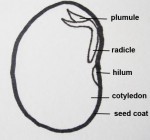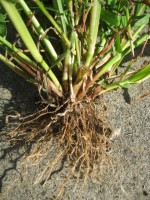 Roots are important to a plant for anchorage, absorption of water and nutrients, support of the stem, and storage of food and nutrients. Some plants need long roots that can anchor them against high winds or absorb water from great depths while others need roots that can catch light rains when they fall. The root of specific kinds of plants varies with the environment in which the plant evolved so that it could meet the needs of the plant.
Roots are important to a plant for anchorage, absorption of water and nutrients, support of the stem, and storage of food and nutrients. Some plants need long roots that can anchor them against high winds or absorb water from great depths while others need roots that can catch light rains when they fall. The root of specific kinds of plants varies with the environment in which the plant evolved so that it could meet the needs of the plant.
 Two major patterns have evolved; taproots and fibrous root systems. The most familiar example of a taproot is probably a carrot. The large orange vegetable that we eat is called the primary root and the tiny hairs you can see if you look closely are lateral roots. Dig up a dandelion and you will see a taproot with many lateral roots. The taproot is formed from the first root (radicle) that originates at the lower end of the embryo when a seed germinates. The radicle elongates downward into the soil and then enlarges in diameter as time goes by. Some taproots store a large amount of food for the plant and if it is tasty we harvest the plants and eat the taproot. In addition to carrots, turnips, parsnips, beets and salsify are edible and tasty taproots. Taproots generally have a limited amount of branching, must be grown in deep, well-drained soil, and are difficult to transplant.
Two major patterns have evolved; taproots and fibrous root systems. The most familiar example of a taproot is probably a carrot. The large orange vegetable that we eat is called the primary root and the tiny hairs you can see if you look closely are lateral roots. Dig up a dandelion and you will see a taproot with many lateral roots. The taproot is formed from the first root (radicle) that originates at the lower end of the embryo when a seed germinates. The radicle elongates downward into the soil and then enlarges in diameter as time goes by. Some taproots store a large amount of food for the plant and if it is tasty we harvest the plants and eat the taproot. In addition to carrots, turnips, parsnips, beets and salsify are edible and tasty taproots. Taproots generally have a limited amount of branching, must be grown in deep, well-drained soil, and are difficult to transplant.

Some plants with taproots will develop a fibrous root system if the taproot is cut early in its development. Nurseries sometimes do this to trees and shrubs so that they will develop a compact, fibrous root system, and can therefore be transplanted more easily and with greater success.
 A fibrous root system develops when the first root stops elongating which causes lateral roots to develop. The lateral roots continue to branch so that a complex mass of roots results. Some plants produce their fibrous root system close to the surface of the soil while others have more deeply in the soil. All the roots in a fibrous root system remain small but the number of roots means that some can be damaged without seriously hurting the plant. This is why plants with fibrous root systems can be transplanted more easily than those with taproots.
A fibrous root system develops when the first root stops elongating which causes lateral roots to develop. The lateral roots continue to branch so that a complex mass of roots results. Some plants produce their fibrous root system close to the surface of the soil while others have more deeply in the soil. All the roots in a fibrous root system remain small but the number of roots means that some can be damaged without seriously hurting the plant. This is why plants with fibrous root systems can be transplanted more easily than those with taproots.
The type of root system is important in growing plants for several reasons. A plant with a shallow, fibrous root system needs frequent watering while one with a deep taproot will require occasional deep watering. A taproot growing in poorly drained soil may rot so care must be taken not to over-water. Most plants with long taproots are difficult to transplant and should be planted initially in the place where they are to grow permanently. If that is not possible, care must be taken to dig down as deeply as possible to get the whole root. The plant may also need special care after transplanting such as reducing the leaf area to cut down on water loss or a special watering regime. Plants with fibrous root systems, on the other hand transplant more easily but care must be taken to dig a large ball of soil and roots so that as many roots as possible are included.

[…] Botany for Gardeners: The Root-Systems […]